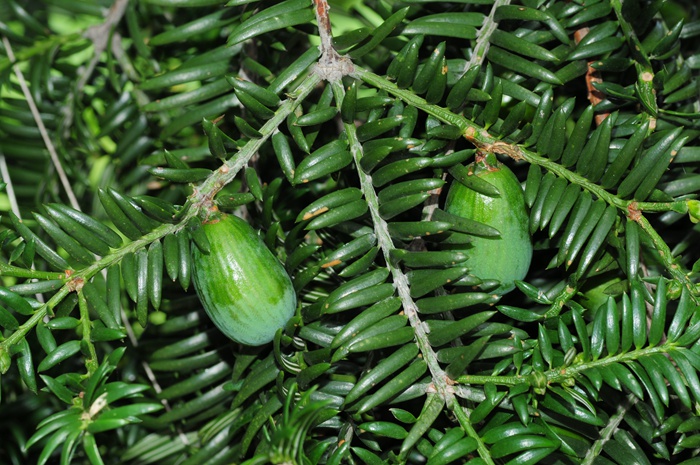- Scientific Name: Torreya grandis Fortune ex Lindl.
- Ref: Gard. Chron. 1857:788. 1857
- Synonyms: Caryotaxus grandis (Fortune ex Lindl.) Henkel & W.Hochst.; Tumion grande (Fortune ex Lindl.) Greene
- English Common Name: Chinese nutmeg yew
- Chinese Common Name: 榧树 fěishù, 圆榧 yuánfěi
- Japanese Common Name: シナガヤ [シナ榧] shinagaya
- Family: Taxaceae
- Genus: Torreya
- Distribution: Mountains, open valleys, often by streams, on yellow, red, and dark soils; 200-1400 m. S Anhui, N Fujian, NE Guizhou, W Hunan, S Jiangsu, N Jiangxi, Zhejiang
- Photo: Mt. Tianmu, Zhejiang
- Note: Torreya grandis ‘Merrillii’ is called 香榧 (xiāngfěi) for its edible seeds.
Trees to 25 m tall; trunk to 0.5(-2) m d.b.h.; bark light yellowish gray, dark gray, or grayish brown, with irregular vertical fissures. Leafy branchlets oblong-obovate in outline, 4-7 × 2.5-4 cm, axis green and glabrous in 1st year, thereafter yellowish green, light brownish yellow or pale brown. Leaves borne at (50-)60-90° to branchlet axis; petiole 0.5-1 mm; blade bright green and glossy adaxially, linear-lanceolate, usually straight, (0.7-)1.1-2.5(-4.5) cm × 2-3.5 mm, with no conspicuous grooves, midvein indistinct adaxially, (0.2-)0.5-0.7 mm wide abaxially, stomatal bands (0.2-)0.3-0.4 mm wide, marginal bands 0.5-0.7 mm wide, base obtuse or broadly rounded, ± symmetric, margin flat or very narrowly revolute, apex symmetrically or slightly asymmetrically tapered, cuspidate, cusp 0.3-1 mm. Pollen cones columnar, ca. 8 mm; bracts conspicuously ridged. Aril pale purplish brown and white powdery when ripe, apex obtuse-rounded or rounded and cuspidatae. Seed ellipsoid to ovoid, elongate-ellipsoid, obovoid, or obovoid-conical, 2-4.5 × 1.2-2.5 cm; female gametophyte tissue slightly wrinkled, not ruminate. Pollination Apr, seed maturity Sep-Nov of 2nd year. (Flora of China)
